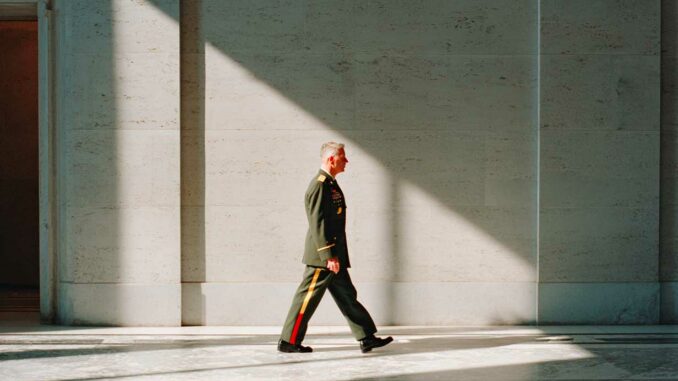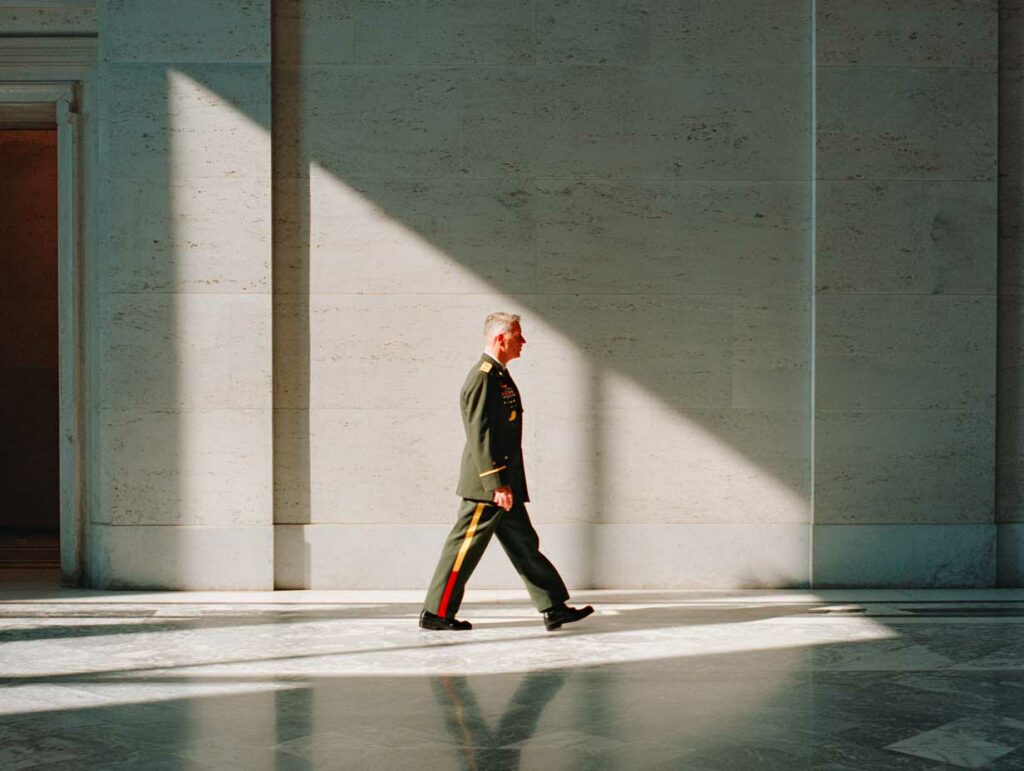
Washington reduces the rank of the commander of USAFE-AFA and Allied Air Command from four stars to three stars. A budgetary decision with strategic implications in Europe.
Summary
On October 2, 2025, the Pentagon decided that the position of commander of the United States Air Forces in Europe – Air Forces Africa (USAFE-AFAFRICA) — which also serves as head of NATO’s Allied Air Command (AIRCOM) in Ramstein — would no longer be a four-star position, but a three-star one. Lieutenant General Jason Hinds was appointed without promotion, a first since the late 1950s. The measure is part of a broader reform aimed at reducing the number of four-star general positions by 20%. In practical terms, the command will continue to oversee approximately 35,000 personnel and nearly 217 aircraft in a theater covering 104 nations, with two CAOCs (Uedem and Torrejón) providing support. However, the downgrading of the rank could weigh on US influence in NATO circles and its peer-to-peer relationship with certain four-star European chiefs of staff, even as interceptions related to Russia remain high (more than 400 in 2024).
The key fact and its immediate context
The Pentagon has officially “downgraded” the position of commander of USAFE-AFAFRICA and, by extension, that of commander of NATO’s Allied Air Command, from four-star general to three-star lieutenant general. The president has forwarded Lt. Gen. Jason Hinds’ nomination to the Senate without the usual promotion to the highest rank. This break with nearly seven decades of practice marks an institutional turning point for the US Air Force in Europe.
The logic of reform at the Pentagon
This decision stems from a directive by Secretary of Defense Pete Hegseth, who in the spring imposed a reduction of at least 20% in four-star general positions (active and National Guard), along with a reduction of at least 10% in all generals and admirals. The stated objective is to “streamline” the senior structure and reallocate resources to the forces. The downgrading of USAFE-AFAFRICA is a concrete application of this policy.
Normal functioning of the command
Traditionally, USAFE-AFAFRICA is one of the major USAF commands based outside the United States. The commander, who until now has been a four-star general, wears three hats: head of USAFE-AFAFRICA, head of NATO’s AIRCOM in Ramstein, and Director of the Joint Air Power Competence Center (JAPCC). In this capacity, he is the Alliance’s air and space advisor and, on the orders of SACEUR, provides the core of the HQ responsible for conducting air operations.
NATO’s operational network: CAOC Uedem and CAOC Torrejón
Under AIRCOM, the Combined Air Operations Centers (CAOC) in Uedem, Germany, and Torrejón, Spain, plan, direct, and supervise air policing on a daily basis. They constitute the operational command level, 24 hours a day, 7 days a week, for surveillance and interception in their respective areas. A third permanent CAOC is to open in Norway for the Far North.

Key figures that frame the challenge
USAFE-AFAFRICA commands more than 35,000 personnel (active duty, reserve, National Guard, and civilian), approximately 217 aircraft (fighter, transport, refueling, and rotary wing), and administers eight wings in Europe, as well as 83 geographically separated units. The theater covers 104 nations and more than 15 million square miles (approximately 38.8 million km²).
Sustained operational activity
In 2024, NATO forces carried out more than 400 scrambles to intercept Russian aircraft approaching allied airspace; the trend for 2025 remains high, particularly over the Baltic and Black Seas. These volumes confirm AIRCOM’s central role in deterrence and air crisis management in Europe.
The effect of rank: a detail of protocol or a real lever of influence?
In NATO, authority derives from position, not just rank. Nevertheless, personal rank influences access, the ability to exert influence in high-level meetings, and the relationship of equals with national chiefs of staff. However, some European counterparts—for example, the British Chief of the Air Staff (Air Chief Marshal)—hold four-star rank. The downgrade to three stars therefore places the American commander below some of his peers, which several observers consider symbolically unfavorable to American influence in decision-making.
The balance of power within the Alliance
In practical terms, a four-star commander has greater credibility when it comes to making capability requests, negotiating rules of engagement, or imposing joint priorities. In a period of recurring tensions with Russia, this symbolic capital can count in NATO committees, in coordination between AIRCOM and the Joint Force Commands, and in the interface with SACEUR (still four stars). The American decision slightly reshuffles the cards of precedence, without changing the operational chain of command.
The impact on the USAF’s posture in Europe and Africa
USAFE-AFAFRICA remains the only US air component that can be immediately deployed to two areas of responsibility (USEUCOM and USAFRICOM), with a full spectrum of missions: air policing, integrated air defense, strategic transport, ISR, evacuations, and multinational training. The reduction in rank does not change the order of battle, the means of alert, or the plans. But it may influence the speed of political decision-making, resource allocation in simultaneous crises (East, Mediterranean, Sahel), and the ability to “impose” priorities on other US components.
The signal sent to allies and competitors
On the allied side, some will see this as budgetary normalization, while others will see it as a signal of relative disengagement by the United States from the European theater, despite the permanence of the tool. For Moscow, the interpretation could fuel a narrative of erosion of authority, hence the importance of compensating with posture: maintaining the pace of exercises, advanced air presence, enhanced interoperability, and rotations of fighter and ISR units. Interception statistics and announcements about a new CAOC in the Far North help to dispel any ambiguity.
Structural reasons: costs, overall staffing levels, and strategic refocusing
The reduction in the number of four-star generals responds to a long-standing criticism: a rank structure deemed too cumbersome, redundancies at the top, and a need to “put muscle back” into operational units. Politically, the administration intends to prioritize refocusing (homeland defense, Indo-Pacific) and greater accountability for allies in Europe and Africa. The downgrading of USAFE-AFAFRICA is part of this trajectory, as are other joint-level adjustments.
Institutional safeguards
Within the Alliance, the status of AIRCOM—the central air and space command—the IAMD structure, and the CAOC chain ensure the continuity of air defense in times of peace and crisis. The robustness of NATINAMDS/ACCS procedures, multinational training (Baltic, Black Sea, High North), and the 24/7 presence of QRA(I) limit the impact of a change in rank on day-to-day operations.
Possible effects on planning and cooperation
In the medium term, the negotiation of national contributions (fighter detachments, AWACS, refueling aircraft), force generation for major exercises, and the prioritization of modernization (C2, ground-to-air defense, multi-sensor ISR) could require additional military diplomacy. A three-star commander remains fully legitimate to lead these projects, but will have to rely more on posture, quantifiable operational performance, and the weight of results (interceptions, scramble times, fleet availability) to convince others.
The operational perspective today
Despite the change in rank, Lt. Gen. Jason Hinds takes the helm of a command with a strong heritage, proven capabilities, and an unchanged operational burden. NATO recorded more than 300 interceptions of Russian aircraft in 2023 and more than 400 in 2024, illustrating the constant pressure on Air Policing. The situation in 2025—incursions, drones, reconnaissance—maintains the requirement for high responsiveness, where the effectiveness of the C2 chain and the reliability of coordination rules are paramount.
The question that remains
The heart of the matter is not so much the missing star as the ability to maintain the operational tempo, to guide allied investment (radars, C2, ammunition, ground-to-air defense), and to preserve decision-making ascendancy within NATO. In this regard, the downgrading of rank imposes above all an imperative for visible results—availability, warning times, interoperability—so that American influence remains aligned with its historical role in European air security.
War Wings Daily is an independant magazine.